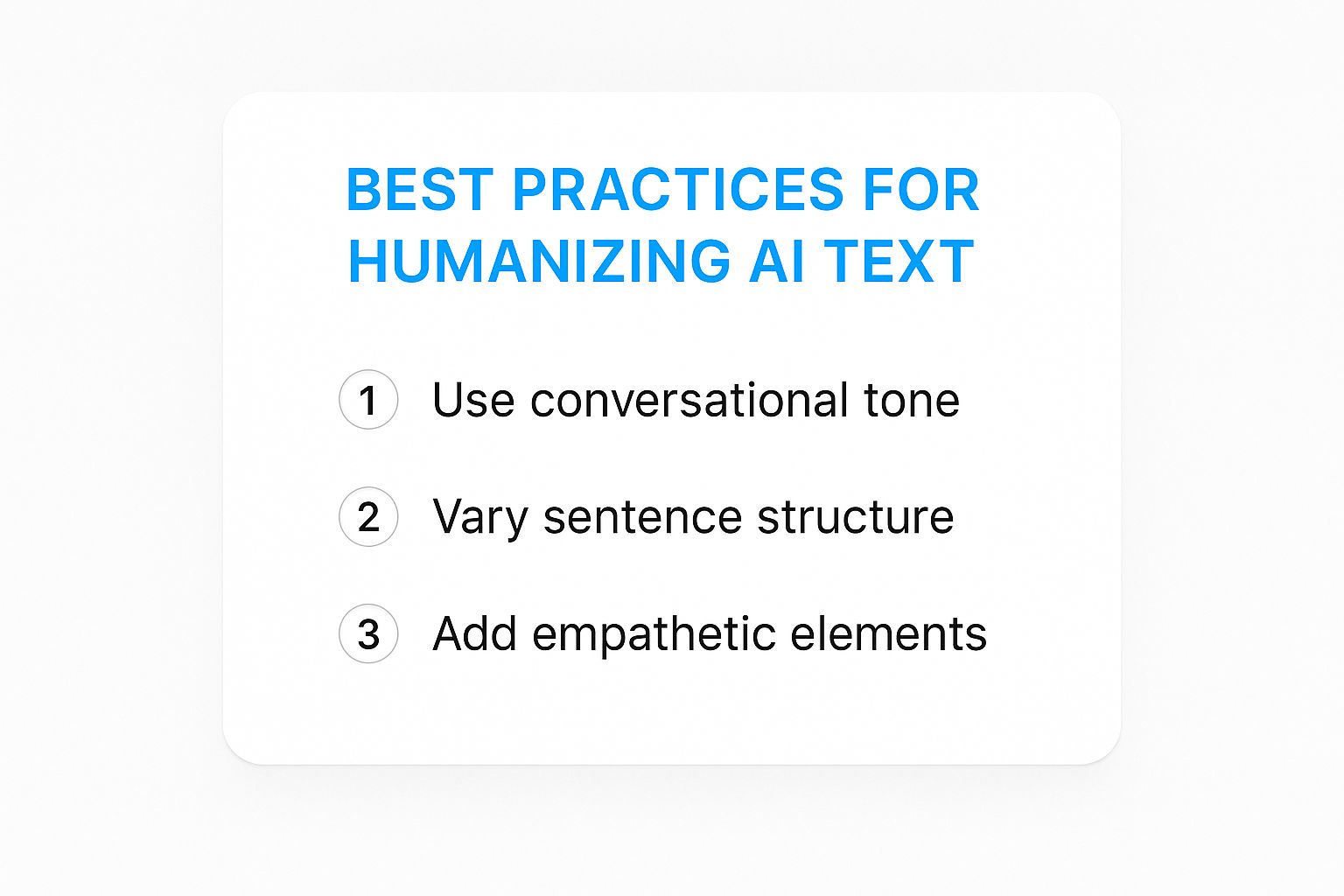Your Guide to AI Text Humanizer Tools

An AI text humanizer is a tool designed to take AI-generated content and polish it, stripping away the robotic, often predictable output and replacing it with writing that feels natural and authentic. Think of it as the crucial finishing touch, adding the personality and nuance that standard AI models just can't replicate on their own.
Why Humanizing AI Content Matters Now More Than Ever
It helps to think of an AI text humanizer as a skilled film editor. A generative AI can pump out the raw footage—all the basic words and sentences—but it often lacks a compelling rhythm or story. The editor is the one who steps in to cut, re-sequence, and polish that footage, shaping it into something that actually captivates an audience. A humanizer does the same for raw AI text.
The main issue with unedited AI content is its tell-tale robotic tone. It might be grammatically perfect, but it often feels lifeless. It’s missing the unique voice and emotional depth that builds a real connection with readers, and that's a growing problem as more and more AI content floods the internet.
The Rise of AI in Content Creation
Let's be clear: AI's role in content creation isn't some far-off future concept; it's happening right now. Projections show that by 2025, an estimated 90% of content marketers will regularly use AI writing tools. The need for speed and efficiency is real, but so is the need for authenticity.
To see just how different the output is, take a look at this side-by-side comparison. It really highlights what changes when you move from raw AI text to something properly humanized.
AI-Generated Text vs. Humanized Text at a Glance
| Characteristic | Standard AI-Generated Text | Humanized AI Text |
|---|---|---|
| Tone & Voice | Often flat, predictable, and overly formal. | Natural, engaging, and reflects a distinct personality. |
| Sentence Structure | Tends to be repetitive and lacks variation. | Mixes short, punchy sentences with longer, complex ones. |
| Word Choice | Uses common, safe vocabulary; can feel generic. | Employs richer vocabulary, idioms, and unique phrasing. |
| Reader Connection | Feels distant and fails to build trust. | Creates a genuine connection and builds rapport. |
| AI Detection | Easily flagged by AI detection tools. | Much harder for AI detectors to flag. |
| Originality | Can sound like a summary of existing online content. | Infuses fresh perspectives and original thought. |
As you can see, the difference isn't just cosmetic. It's about transforming a piece of text from a functional but sterile asset into a powerful communication tool that actually resonates with people.
An AI text humanizer bridges the gap between machine efficiency and human relatability. It allows creators to produce content at scale without sacrificing the authenticity that builds trust and engages readers.
These tools are becoming more important every day, especially when you look at the key publishing industry trends that show AI's growing role in digital media. Humanization is no longer a "nice-to-have"—it's an essential step for effective SEO, audience engagement, and protecting your brand's voice.
If you want a more detailed guide, we have a complete walkthrough on how to humanize AI content effectively.
How AI Humanizers Actually Mimic Human Writing
To really get what an AI text humanizer does, you need to think beyond simple synonym-swapping. These tools aren't just a fancy thesaurus. A better analogy is a skilled composer who knows music is more than just a string of notes—it’s about the rhythm, the tempo, and the critical pauses that create feeling.
In the same way, these tools don’t just change a few words. They deconstruct and then rebuild the text to match the slightly messy, unpredictable flow of human thought. The mission is to take content that’s grammatically perfect but feels cold and sterile, and inject it with a genuine voice and personality.
It's More Than Just Basic Rewriting
The real magic happens when an AI humanizer gets to work on two specific metrics that almost always give away AI-generated text: perplexity and burstiness.
-
Perplexity is just a fancy way of measuring how predictable a text is. AI models are trained to pick the most statistically probable next word, which results in text that is incredibly logical but feels flat and robotic. A humanizer throws a wrench in that predictability, intentionally using less common words and more varied sentence structures to increase perplexity. The result? The content is less predictable and far more interesting to read.
-
Burstiness is all about the rhythm and variety of your sentences. Think about how you talk or write. You naturally mix short, punchy sentences with longer, more detailed ones. AI text often lacks this natural cadence, leading to monotonous paragraphs where every sentence feels the same length. Humanizers fix this by actively changing up sentence lengths, creating a more dynamic and natural reading experience.
By focusing on perplexity and burstiness, an AI text humanizer isn't just editing—it's essentially reverse-engineering the unique cadence of human conversation. It shatters the robotic uniformity and creates a flow that feels completely authentic.
At its core, this whole process relies on sophisticated algorithms that take the original AI output apart piece by piece. They analyze everything—sentence patterns, word choices, logical flow—and then put it all back together in a way that captures the subtle imperfections and natural variations of human writing. This not only makes the content more engaging for readers but also makes it much harder for AI detection tools to flag.
The Real-World Benefits of Humanized AI Content
Using an AI text humanizer is about much more than just cleaning up awkward phrasing. It's a strategic move that delivers real, measurable wins for your brand, your audience, and your workflow. These tools aren't just for style points; they’re for results.
One of the biggest real-world perks is how humanized text plays nice with search engines. It can help you rank higher on Google because the content comes across as natural and authoritative. Search algorithms are smart enough to reward content that genuinely helps people, and humanized text signals originality, avoiding the red flags of low-effort, robotic articles.
Build Trust and Boost Efficiency
Another massive advantage is the ability to forge a real connection with your readers. When someone lands on your site and the text feels authentic and relatable, they're far more likely to trust your brand. This is how you turn a skeptical visitor into a loyal follower—by avoiding that sterile, off-putting tone that immediately screams "robot."
Humanized content doesn't just inform; it connects. It bridges the gap between machine-generated speed and the genuine voice readers crave, building the trust necessary for long-term engagement.
Finally, humanizing AI text is a game-changer for content creation efficiency. You get the perfect partnership without sacrificing quality. It’s a simple, powerful system:
- AI for Speed: Churn out initial drafts, outlines, and core ideas in a fraction of the time it would take to write from scratch.
- Humanizer for Quality: Quickly polish that raw output, injecting the nuance, personality, and flow that make it ready for your audience.
This two-step process empowers teams to scale their content production massively. A marketing agency can double its blog output, or a student can efficiently refine an AI-assisted research paper. You get the best of both worlds—the raw speed of a machine and the authentic touch that makes content truly work.
How to Choose the Right AI Text Humanizer
With a flood of new tools hitting the market, picking the right AI text humanizer can feel like trying to find a needle in a digital haystack. The trick is to look past the flashy marketing and focus on what actually matters for your work, whether you're a content pro churning out articles or a student trying to polish an essay.
Choosing a tool isn't just about finding one that works—it's about finding one that fits right into your existing process. A casual blogger might just need a simple, free tool for occasional tweaks. But a marketing agency? They'll need a powerhouse platform with deep customization to keep their brand voice consistent across hundreds of posts.
Core Features to Compare
When you start looking at your options, you'll want to zero in on these four key areas. They’re what separate the genuinely useful tools from the simple synonym-swappers.
- Sophistication of Output: Does the tool just do a basic word swap, or does it actually restructure sentences to make them flow better? The best tools understand context and produce writing that's natural and engaging.
- AI Detection Evasion: Let's be honest, a big reason you're here is to create content that doesn't get flagged by AI detectors. Look for tools that openly talk about their ability to bypass these checks and, even better, give you some kind of score or analysis.
- Ease of Use: The interface needs to be intuitive. You shouldn't have to pull up a user manual just to humanize one article. A clean, simple user experience means you can get your work done faster and without the headache.
- Customization and Control: Can you steer the output in the right direction? The top-tier tools let you define a specific tone—like professional, witty, or empathetic—which is absolutely critical for maintaining a consistent brand identity.
This image breaks down the core practices a good humanizer should help you nail.
As you can see, humanizing isn't just a technical game of cat-and-mouse with detectors. It's about making your content more conversational and connecting with your reader on a human level.
Feature Comparison of Popular AI Humanizer Tools
To help you navigate the crowded market, here’s a quick comparison of some leading tools. This table breaks down what each one offers, so you can see at a glance which might be the best fit for your specific goals and budget.
| Tool | Best For | Key Feature | Pricing Model |
|---|---|---|---|
| Word Spinner | Bloggers & content creators | All-in-one humanizer and AI detector | Freemium/Subscription |
| Undetectable AI | Professionals needing high bypass rates | Advanced algorithms for deep-level rewriting | Subscription |
| StealthWriter | Students & academics | Multiple humanization modes and plagiarism checks | Subscription |
| QuillBot | General use and basic paraphrasing | Co-Writer, Grammar Checker, and Paraphraser | Freemium/Subscription |
Each tool has its own strengths. The right choice depends on whether you prioritize advanced features, ease of use, or simply the best possible price point.
Finding the Right Fit for Your Needs
The competition among these tools is getting fierce. By 2025, you can expect to see at least 10 major platforms vying for your attention, all designed to turn robotic AI text into something that reads like it was written by a person.
Some tools offer impressive stats. For instance, platforms are now achieving AI detection scores as low as 13% with their paid plans. It's a clear sign of how sophisticated this technology is becoming.
As you evaluate the different AI tools out there, it's smart to look beyond just humanizers. For a wider view of what’s available, this list of the 12 Best AI Tools for Authors in 2025 is a great resource.
Ultimately, choosing the right tool is a balancing act between your budget and your standards for quality. For a much more detailed comparison of specific tools and what they're good for, check out our guide on what is the best AI humanizer.
Best Practices for Using a Humanizer Effectively
To get the most out of an AI text humanizer, it helps to think of it less like a magic wand and more like a highly skilled writing assistant. These tools are fantastic for polishing and refining content, but they work best when you give them something solid to start with. A clear, well-prompted AI draft is the first step to a brilliant final product.
Simply put, a humanizer is there to make good content great. It's not designed to rescue a jumbled, poorly written mess. The quality of what you get out is directly tied to the quality of what you put in.
Refine in Batches and Experiment
Instead of dumping a huge wall of text into the tool all at once, try breaking it down. Feed your content into the humanizer in smaller, more manageable chunks. This approach often delivers more nuanced and context-aware results because the tool can focus its attention on each paragraph.
Also, don't be afraid to play around with the settings. The best humanizers aren't one-size-fits-all; they come with a variety of customization options. Many advanced platforms now let you get incredibly specific with tone customization and even offer multilingual support to boost authenticity. Some tools let you choose from over a dozen distinct tones—from persuasive to friendly—and can adapt content across many languages.
The golden rule of humanization is to always perform a final human review. This is the non-negotiable last step where you transform a great piece of content into an exceptional one.
That final, manual pass is where the real magic happens. It’s your opportunity to weave in personal stories, double-check your facts, and make sure the text truly sings in your brand's unique voice. For more hands-on tips, be sure to check out our guide on the 10 best ways to humanize your AI-generated content.
Common Questions About AI Text Humanizers
As you dive into the world of AI text humanizers, it’s natural to have a few questions pop up about how these tools actually work and where they fit into a solid content strategy. Let's clear up some of the most common points of confusion so you can start using them with confidence.
One of the biggest worries we hear is whether using a humanizer is a form of cheating or plagiarism. The short answer is no. A humanizer is best thought of as a highly advanced editing partner, not a content thief. As long as you begin with material you have the right to use, the tool simply reframes and restructures it to make it more unique and readable. It’s not much different from using a powerful thesaurus or grammar tool to polish your draft.
Another hot-button question is about search engines. Will Google bring down the hammer on you for using humanized content?
Google's primary mission is to rank content that is helpful, high-quality, and written for people first. An AI text humanizer is specifically engineered to lift AI-generated text to meet that exact standard of quality.
Because humanized content is, by its nature, more original and valuable to a reader, it aligns perfectly with what search engines want to see. It’s a completely safe and effective way to approach content creation.
Do I Still Need a Final Edit?
Yes, absolutely. Running a final human review over the text is always a smart move. An AI text humanizer is an incredibly powerful assistant, but it’s not infallible.
That final read-through is your chance to weave in personal stories, double-check specific facts, and make sure the tone is a perfect match for your brand's voice. Think of the tool as doing 90% of the heavy lifting. Your final touch adds that last 10% that takes the content from good to flawless. This last step is also a huge part of making sure your content feels truly authentic, which is a major factor when you consider if people can detect AI writing in the first place.
Ready to create authentic, engaging content that bypasses AI detectors and resonates with your audience? Try Word Spinner today and see the difference for yourself. Start your free trial now!



